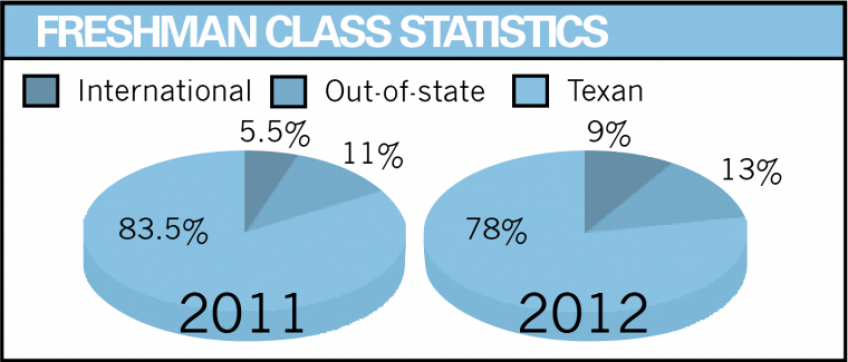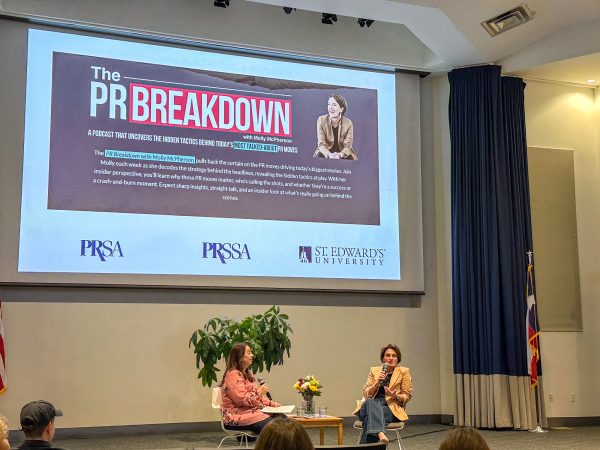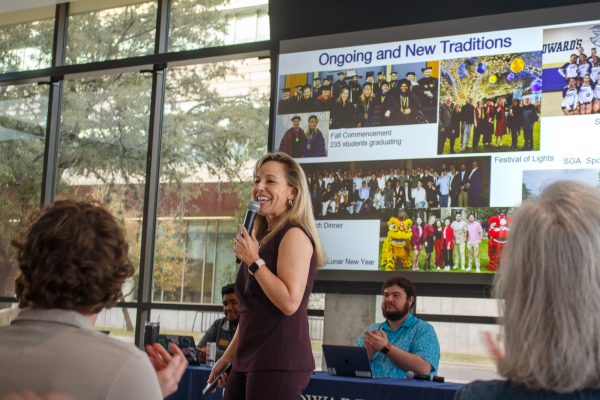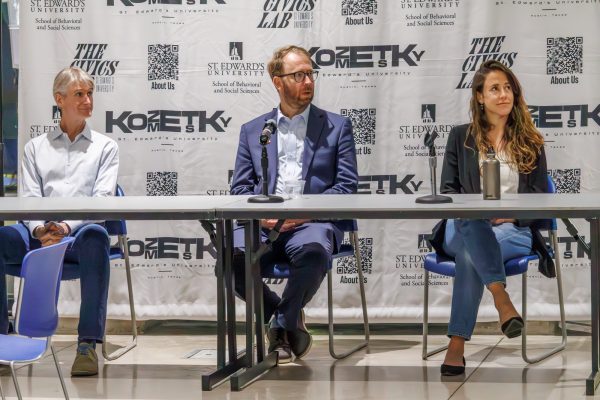President’s meeting details global initiatives, campus projects
The freshman class includes 72 international students compared to 43 in 2011. The class of 2016 also has 102 students from states outside of Texas, up from 86 last year.
St. Edward’s University’s fall president’s meeting updated students and faculty on the university’s progress and provided a glimpse into plans for the new academic year.
“If I was to summarize it in a phrase, I would say things are pretty darn good,” President George Martin said.
The presentation on Sept. 25 focused on the university’s growth in academics around the world and on the home campus itself.
Martin began with a summary of recent academic achievements. The U.S. World News Report moved St. Edward’s up to number 17 in the Regional University West division. The university’s average SAT score climbed to 1130. St. Edward’s continues to be a top producer of Fulbright scholarship winners, and was named once again to the President’s Higher Education Community Service Honor Roll.
The university also secured $1.15 million for the McNair Scholars Program, a program that prepares students for doctoral studies through involvement in research and other scholarly activities. St. Edward’s has received federal funding for the McNair Scholars Program for the past nine years, but there was some uncertainty this year as to whether funding for the program would be cut.
“I am so excited that we were funded again for McNair. That was very exciting… I think it is a wonderful opportunity,” English writing and rhetoric professor and Associate Dean Lynn Rudloff said.
Martin said a total of $19 million, which will go towards scholarships and research on campus, was raised in the 2012 fiscal year.
“From this point on, almost the entire focus is on building the endowment so that we can provide more scholarship money for students and more research money for faculty,” Martin said.
In addition to academic improvements, Martin also stressed the university’s evolving global perspective. Involvement with other cultures on an international level is one of the main tenets of the university’s strategic plan for 2015.
To highlight this commitment to global preparedness, Martin discussed a recent study abroad trip to Thailand and Malaysia during which Father Louis Brusatti led 25 students to learn about Asian religious traditions alongside students from Japan, China and South Korea.
This distinctive mixing of cultures is the kind of experience Martin said the university seeks to provide for its students.
“It achieved goals that we are really trying to achieve in education… We do not want our students to be in a bubble. We want them to be totally integrated with students from other cultures,” Martin said.
The university plans on developing even more partnerships and programs in different countries in the coming years.
“In terms of global preparedness, we continue to spread St. Edward’s in all parts of the world. We expect to expand further this year into other parts of the world,” Martin said.
Martin revealed plans for a partnership with Curtin University in Australia, which is meant to extend study abroad opportunities to students of all majors.
“It seems like an absolute first rate program, and I am particularly pleased because it is a program that our science students can participate in,” Martin said.
Senior Ashton Robison shares this enthusiasm for global learning and cross-cultural experiences.
“I studied abroad in Tanzania and in France, so that is half of why I go to St. Ed’s, for that global perspective,” Robison said.
Senior Patrick Dunlap feels the same way, having studied abroad in Uganda.
“As a global studies major, that was really important to me… It is becoming such a big part of campus, of the St. Ed’s community,” Dunlap said.
Besides expansion abroad, Martin also discussed the university’s growth at home on the Hilltop.
Martin said the 2012-2013 freshman class contained the highest percentage of out-of-state students in the university’s history.
“That was a long and hard effort. We have been working at that for over 10 years, and finally it is beginning to pay off,” Martin said.
The international student population has increased greatly as well, Martin said, likely due to the university’s global connections.
“We have the largest international class in recent history. In fact, we looked back and just about five years ago there were only 10 international students in the freshman class, and we came in with 72 this year,” Martin said.
Besides the growing student population, one of the biggest changes on campus is the renovation of the Scarborough-Phillips Library. Martin emphasized how this new library was designed to keep up with the university’s physical and academic growth.
“It is going to be more than double the size of the library now. It will bring us into 21st century research,” Martin said.
The library, scheduled to open in fall 2013, will offer brand new design and modernized resources for students.
“There will be a bridge going across the top connecting the two ends of the library… There will be two global classrooms in there initially and eventually four global classrooms and lots and lots of technology,” Martin said.
Martin ended the meeting honoring the five professors the university has lost in the past year, Cecil Lawson, Marcia Kinsey, Edward Shirley, Jean McKemie and Harald Becker.
“Even though we feel their loss… the real message in all of that is how fortunate we were, how blessed we were, to have those people as part of our community and how blessed we are to have so many others as part of our community,” Martin said. “We need to carry on their work with our students.”







